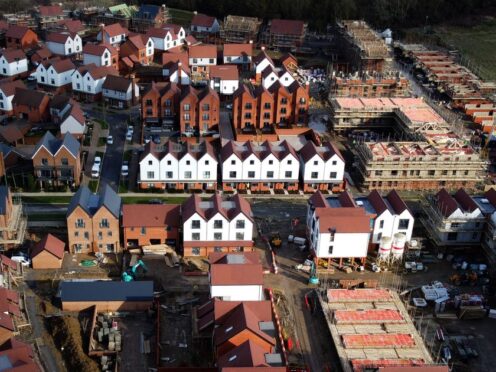
The UK’s construction industry showed signs of stabilising last month, with builders feeling the most optimistic in more than two years, according to a new survey.
Nevertheless, companies shed jobs at the fastest rate since 2020 in the fallout from a prolonged housebuilding slump.
The latest S&P Global/CIPS construction purchasing managers’ index (PMI) scored 49.7 in February, up from 48.8 in January.
It came in just a fraction below the 50.0 threshold, with any score below that indicating output in the sector is shrinking, and anything above indicating it is growing.
Analysts had predicted a score of 49.0 for February.
An improvement in market conditions laid the foundations for residential construction work to stabilise, the survey found.
Stronger demand helped lead to a pick-up in new orders.
In contrast, commercial construction work – like offices and warehouses – remained subdued, with builders saying clients were hesitant to commit to new work and stretch their budgets.
Tim Moore, economics director at S&P Global Market Intelligence, said: “This was the best performance for the construction sector since August 2023 and the forward-looking survey indicators provide encouragement that business conditions could improve in the coming months.”
Business optimism was at the highest level since January 2022, with construction firms feeling hopeful of customer demand lifting and economic conditions improving this year, the PMI survey showed.
“However, a protracted downturn in activity has made construction companies cautious about their employment numbers,” Mr Moore added.
“Staffing levels dropped for the third time in the past four months and the latest round of job shedding was the steepest since November 2020.”
The survey found that pressure to raise staff wages combined with less work led some firms to take steps to cut costs, or choose not to replace staff leaving their jobs.
Rob Wood, chief UK economist for Pantheon Macroeconomics, said the expectation of a fall in interest rates, which have pushed up the cost of borrowing, has “breathed life into housebuilding”.
“House-buyers returning to the market as expectations of interest rate cuts have grown helped construction output to stabilise in February,” he said.
“Builders’ surging confidence in the outlook suggests construction output will grow again soon.”

Enjoy the convenience of having The Sunday Post delivered as a digital ePaper straight to your smartphone, tablet or computer.
Subscribe for only £5.49 a month and enjoy all the benefits of the printed paper as a digital replica.
Subscribe